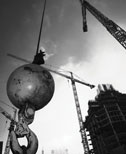There is no such thing as the perfect product, but there are ways to find the most suitable material for each roofing application. For every roofing job, you review the specifications, understand your customer's wish list, examine the building and consider which roof system will meet your customer's needs. When considering metal shingles, knowing their good and bad attributes will help you determine whether they are the best fit for your project.
The good
Long service life
When buying any product, you want it to last. Metal has been proven to last longer than many other materials. According to a Troy, Mich.-based Ducker Worldwide study in 2007, a nonmetal roof lasts 15 to 23 years—composite shingles, 15 years; single-ply membranes, 20 1/2 years; polymer-modified bitumen, 23 years; and built-up roofing, 23 years—compared with metal roofing, 41.6 years. For a building owner, this difference in life span means cash savings.
Some reasons metal shingles last so long include the base material and coating. Shingles typically are formed from galvanized steel, Galvalume® or aluminum. Other materials, such as copper or zinc, also are popular choices. No matter the metal type, the material lasts. A look at roofs in Europe or older U.S. cities and towns reveals the history of metal and its proven longevity.
Environmental benefits
A longer service life also adds sustainable aspects to a roofing job. An environmentally conscious building owner appreciates a product that isn't periodically dumped in a landfill. An additional benefit is metal shingles typically don't end up in a landfill because they can be recycled at the end of their useful lives.
"The amount of recycled content in each metal product varies by the metal supplier and metal manufacturer," says Jim Bush, vice president of sales for ATAS International Inc., Allentown, Pa. "But all metal materials can be recycled once their life spans are complete."
Paint coatings also can reduce energy consumption, improve solar reflectance and limit the urban heat-island effect. According to Lawrence Berkeley National Laboratory, Berkley, Calif., metal roof systems coated with Kynar 500® or Hylar® 5000 reduce energy consumption 40 percent.
Also, metal roof systems can achieve a solar reflectance of 70 percent, meaning the heat from the sun isn't transferred into a building. The color coating selected and other factors will affect roofs' and buildings' energy efficiencies. When reviewing color and finish options, work closely with the manufacturer and designer to ensure specifications meet the building owner's needs. Many manufacturers offer cool coatings, which have been tested by third parties and proved to be efficient. Some coatings also are ENERGY STAR®-certified.
Tax credits for homeowners who update their homes with energy-efficient materials are available, and you should encourage building owners to check with their local governments to see whether state credits also are available. Insurance companies could be a source of additional discounts, as well. And some states, such as Texas, offer deductions when Class 4 hail- and wind-resistant materials, such as metal roofing, are used. Metal shingles also can contribute LEED® points to a project and bring ENERGY STAR-certified products to a building.
"A contractor who recommends metal needs to understand metal's selling points," Bush notes. "Sustainability is a way of life for many, not just a trend. Contractors would be wise to offer a material that lasts twice as long as others, has recycled content and is recyclable, creates more energy-efficient spaces, and provides tax or insurance credits."
Proven durability
A high-quality manufacturer will subject its metal shingle product lines to testing for corrosion resistance and wind uplift. Many metal shingle systems are designed to resist 150-mph winds, and homeowners living in coastal areas appreciate this benefit. Homeowners living in areas prone to wildfires or with fire classifications required by code also pay attention to metal's ability to resist fires. When a roof is the largest surface area of a home, it makes sense to provide a roof assembly resistant to severe fire exposure.
Roof assemblies with fire ratings from Underwriters Laboratories Inc. or ASTM International are rated as Class A, B or C. Assemblies with a Class A rating are effective against severe fire test exposure; products with a Class B rating have the ability to withstand a moderate amount of fire test exposure; and products with a Class C rating only can withstand a small amount of fire test exposure.
Many metal roof assemblies are rated Class A. Other types of roof assemblies, such as clay and concrete tile, also frequently receive a Class A rating. However, weight and wind uplift should be considered when comparing these roofing options.
"Building owners need to pay attention to fire ratings," Bush says. "But they also should consider the complete package to determine how a roof will perform in an intense storm or fire."
Aesthetically pleasing
As a roofing contractor, you can sell a roof system based on all these attributes. However, a building owner may not pay attention unless the new roof system will look good. Metal shingles are available in a variety of shapes, sizes, styles and colors to meet homeowners' needs and desires. There are metal profiles that look like a typical shingle, shake or tile, as well as those that have unique diamond patterns. Shingles that look similar to the well-known standing-seam panels also are available.
Color options add even more variety. Several manufacturers offer custom colors, which many building owners appreciate. Retail owners, for example, value color coating options because the roof color can complement corporate image or branding.
The bad
Not-so aesthetically pleasing
Just as the aesthetics of metal can be a selling point, the look of metal shingles also can be a deterrent. Not every region is accustomed to the aesthetics of a metal shingle roof system, so some building owners negatively perceive metal. Metal also cannot be installed in every neighborhood. Those with homeowners associations need to verify metal shingles are permissible. If metal isn't allowed, this is a great opportunity for metal education.
"Contractors who install metal can reach out to various manufacturers, associations and publications for materials to help educate building owners, homeowners associations and municipalities about metal's benefits. Resistance to using metal often exists simply because people are not educated about the material and its attributes," Bush explains.
More expensive
Costs may be higher for a metal roof than another roofing material, but the price gap is closing. Roofing contractors can overcome this issue by reiterating to customers metal lasts longer and provides a better appearance. Buying a metal roof can be a lasting investment compared with replacing asphalt shingles multiple times over the life of a home. Tax and insurance credits also can help offset costs.
Failure to perform
Metal shingles, similar to other roofing products, can fail if they are not installed properly. Making sure your crew knows how to install metal shingles properly is vital to a roof system's look and performance. If you are new to installing metal shingles, know that installing metal is different from installing asphalt shingles, and your workers need to be trained. Take the time to educate your crews so roofing workers can succeed at their jobs. They most likely will discover installing metal shingles is not difficult or time consuming. Some manufacturers offer classroom and hands-on training. In addition, associations have certification programs that add value to a company's repertoire.
These training programs will reveal adding flashings to a metal shingle system requires attention to detail and more installation time. Similar to installing a shingle, the flashings need to be installed precisely—failure to do so can result in water leakage and damage issues, which can deter some contractors from getting into the metal business. However, the flashings also can be viewed as a bonus; they add longevity to a roof system because they add redundancy in waterproofing.
Contractors who already work with metal shingles know selling a metal shingle roof system can be difficult. Because it's not a frequently used product, building owners tend to have a lot of questions and preconceived notions about the material. Marketing pieces and presentations about metal shingles can help you overcome these hurdles. Again, turn to your manufacturer or association for assistance.
The usage
The Metal Roofing Alliance (MRA) began tracking the residential roofing market in 1998, the same year the alliance was formed. That year, metal comprised 2 percent of the new home construction market and 4 percent of the residential reroofing market. In 2009, MRA asked McGraw-Hill Construction and Analytics to perform a follow-up survey. The survey showed a 5.5 percent market share in new construction and an 11 percent market share in residential reroofing.
"These numbers show metal is gaining in acceptance by building owners," Bush says. "Obviously, as a member of the metal construction industry, I want to see even more growth. But more importantly, I want to see roofing contractors educating building owners about the use of metal and selling metal's attributes."
Making the right choice
Education is key when selecting the right roofing material for a project, and you might find metal shingles may not be the right choice for your next installation. Nonetheless, understanding the good and bad about metal shingles will assist you during the decision-making process with your customers.
Kate Gawlik is a marketing consultant for ATAS International Inc., Allentown, Pa.



